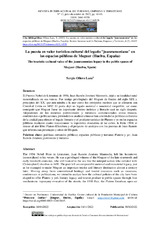Mostrar el registro sencillo del ítem
La puesta en valor turístico-cultural del legado “juanramoniano” en los espacios públicos de Moguer (Huelva, España)
| dc.contributor.author | Ollero Lara, Sergio | |
| dc.date.accessioned | 2022-12-27T11:08:19Z | |
| dc.date.available | 2022-12-27T11:08:19Z | |
| dc.date.issued | 2022 | |
| dc.identifier.issn | 2530-7134 | |
| dc.identifier.uri | http://hdl.handle.net/10396/24468 | |
| dc.description.abstract | El Premio Nobel de Literatura de 1956, Juan Ramón Jiménez Mantecón, dejó a su localidad natal inmortalizada en sus versos. Fue testigo privilegiado del Moguer de finales del siglo XIX y principios del XX, que aún miraba a la mar como los intrépidos marinos que se alistaron con Cristóbal Colón en 1492. El poeta dejó un legado material e inmaterial irrepetible, así como consiguió que Moguer fuese un importante destino turístico y literario casi un siglo después. Alejándonos de los recursos patrimoniales y turísticos convencionales como museos, conferencias o publicaciones, pretendemos analizar cómo se han amoldado las políticas culturales de la ciudad para ofrecer el legado literario y el producto turístico de Platero y yo en los espacios públicos mediante cuatro mecanismos: la toponimia evocadora de las calles, la Feria 1900, el museo al aire libre Platero EScultura y el proyecto de azulejos con los poemas de Juan Ramón que referencian personajes y sitios de Moguer. | es_ES |
| dc.description.abstract | The 1956 Nobel Prize in Literature, Juan Ramón Jiménez Mantecón, left his hometown immortalized in his verses. He was a privileged witness of the Moguer of the late nineteenth and early twentieth centuries, who still looked to the sea like the intrepid sailors who enlisted with Christopher Columbus in 1492. The poet left an unrepeatable material and immaterial legacy, just as he managed to make Moguer an important tourist and literary destination almost a century later. Moving away from conventional heritage and tourist resources such as museums, conferences or publications, we intend to analyze how the cultural policies of the city have been shaped to offer Platero y yo's literary legacy and tourist product in public spaces through four mechanisms: toponymy evocative of the streets, the 1900 Fair, the Platero Escultura open-air museum and the tile project with the poems of Juan Ramón that refer to characters and places in Moguer. | es_ES |
| dc.format.mimetype | application/pdf | es_ES |
| dc.language.iso | spa | es_ES |
| dc.publisher | UCOPress | es_ES |
| dc.rights | https://creativecommons.org/licenses/by-nc/4.0/ | es_ES |
| dc.source | Revista Internacional de Turismo, Empresa y Territorio (RITUREM) 6(2), 48-65 (2022) | es_ES |
| dc.subject | Políticas culturales públicas | es_ES |
| dc.subject | Espacios públicos y turismo | es_ES |
| dc.subject | Platero y yo | es_ES |
| dc.subject | Jiménez, Juan Ramón, 1881-1958 | es_ES |
| dc.subject | Patrimonio y turismo | es_ES |
| dc.subject | Public cultural policies | es_ES |
| dc.subject | Public spaces and tourism | es_ES |
| dc.subject | Platero and me | es_ES |
| dc.subject | Heritage and tourism | es_ES |
| dc.title | La puesta en valor turístico-cultural del legado “juanramoniano” en los espacios públicos de Moguer (Huelva, España) | es_ES |
| dc.title.alternative | The touristic-cultural value of the juanramonian legacy in the public spaces of Moguer (Huelva, Spain) | es_ES |
| dc.type | info:eu-repo/semantics/article | es_ES |
| dc.relation.publisherversion | http://www.uco.es/ucopress/ojs/index.php/riturem/index | es_ES |
| dc.rights.accessRights | info:eu-repo/semantics/openAccess | es_ES |

